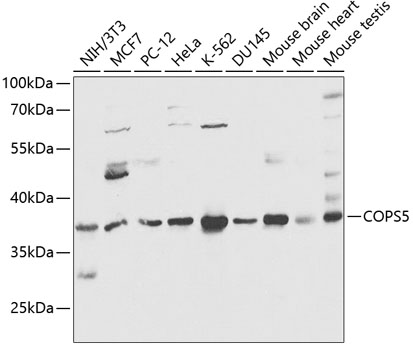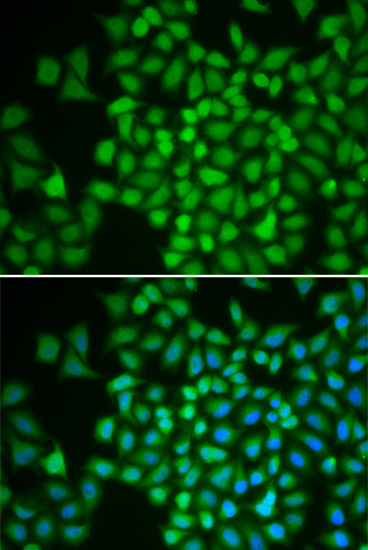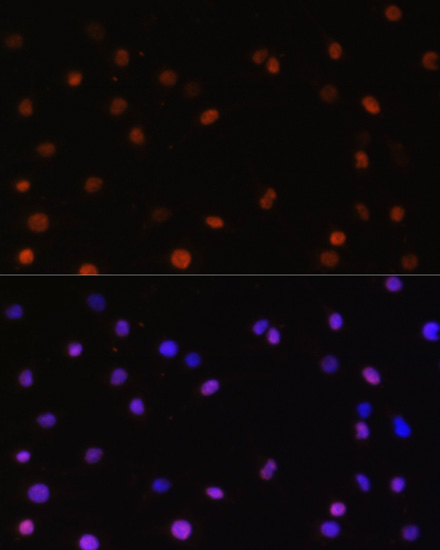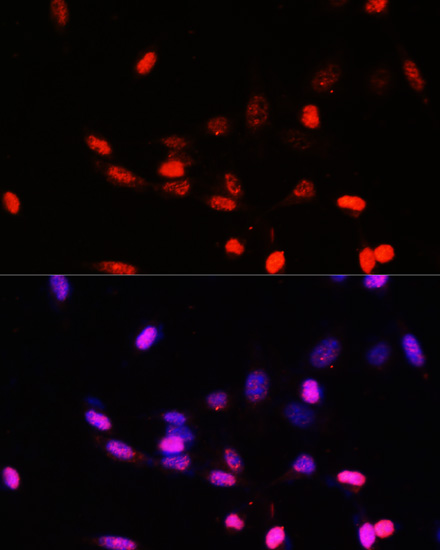-
Product Name
COPS5 Polyclonal Antibody
- Documents
-
Description
Polyclonal antibody to COPS5
-
Tested applications
WB, IHC, IF
-
Species reactivity
Human, Mouse, Rat
-
Alternative names
COPS5 antibody; CSN5 antibody; JAB1 antibody; MOV-34 antibody; SGN5 antibody; COP9 signalosome subunit 5 antibody
-
Isotype
Rabbit IgG
-
Preparation
Antigen: Recombinant fusion protein containing a sequence corresponding to amino acids 1-334 of human COPS5 (NP_006828.2).
-
Clonality
Polyclonal
-
Formulation
PBS with 0.02% sodium azide, 50% glycerol, pH7.3.
-
Storage instructions
Store at -20℃. Avoid freeze / thaw cycles.
-
Applications
WB 1:500 - 1:2000
IHC 1:50 - 1:100
IF 1:50 - 1:100 -
Validations

Western blot - COPS5 Polyclonal Antibody
Western blot analysis of extracts of various cell lines, using COPS5 antibody at 1:1000 dilution.Secondary antibody: HRP Goat Anti-Rabbit IgG (H+L) at 1:10000 dilution.Lysates/proteins: 25ug per lane.Blocking buffer: 3% nonfat dry milk in TBST.

Immunofluorescence - COPS5 Polyclonal Antibody
Immunofluorescence analysis of HeLa cells using COPS5 antibody . Blue: DAPI for nuclear staining.

Immunofluorescence - COPS5 Polyclonal Antibody
Immunofluorescence analysis of C6 cells using COPS5 antibody at dilution of 1:100. Blue: DAPI for nuclear staining.

Immunofluorescence - COPS5 Polyclonal Antibody
Immunofluorescence analysis of NIH/3T3 cells using COPS5 antibody at dilution of 1:100. Blue: DAPI for nuclear staining.
-
Background
Probable protease subunit of the COP9 signalosome complex (CSN), a complex involved in various cellular and developmental processes. The CSN complex is an essential regulator of the ubiquitin (Ubl) conjugation pathway by mediating the deneddylation of the cullin subunits of the SCF-type E3 ligase complexes, leading to decrease the Ubl ligase activity of SCF-type complexes such as SCF, CSA or DDB2. The complex is also involved in phosphorylation of p53/TP53, c-jun/JUN, IkappaBalpha/NFKBIA, ITPK1 and IRF8, possibly via its association with CK2 and PKD kinases. CSN-dependent phosphorylation of TP53 and JUN promotes and protects degradation by the Ubl system, respectively. In the complex, it probably acts as the catalytic center that mediates the cleavage of Nedd8 from cullins. It however has no metalloprotease activity by itself and requires the other subunits of the CSN complex. Interacts directly with a large number of proteins that are regulated by the CSN complex, confirming a key role in the complex. Promotes the proteasomal degradation of BRSK2.
Related Products / Services
Please note: All products are "FOR RESEARCH USE ONLY AND ARE NOT INTENDED FOR DIAGNOSTIC OR THERAPEUTIC USE"
